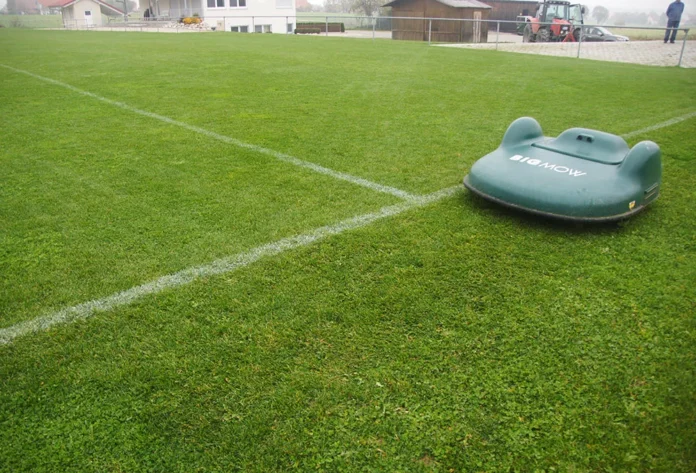Remember the times when field marking for sports was all manual labor? It was backbreaking work that required a hands-on approach and a whole lot of patience. But cue the 21st century, and we’ve welcomed a game-changing player to the field: robots!
If you’re curious to see how these innovative machines operate, keep reading to learn more about it. This isn’t just neat; it’s revolutionary. As we continue to witness advancements in technology, these compact, tireless workers are not only drawing precise lines on sports terrains but are actively redefining the standards and expectations for field preparation.
The Rise of Robotics in Sports Turf Management

Gone are the days when groundskeepers spent countless hours measuring and chalking lines before every game. The transition from manual to automated field marking has been transformative, bringing in a new era of efficiency. These tiny mobile robots, armed with GPS technology, are crafting perfect plays on sports turf. Experience has shown that they’re not only precise but also incredibly swift, changing game preparations from a day-long marathon to a sprint.
While the adoption of robotic technology for field marking is a clear advancement, it also represents a significant shift in turf management as a profession. Groundskeeping staff are now operating technology that requires a blend of traditional greenkeeping knowledge and modern tech-savviness. This progression not only enhances their skill set but also elevates the standards of the playing field to previously unattainable levels, contributing to a more dynamic and cutting-edge sports experience.
Furthermore, the infusion of robotics in sports turf management is catalyzing a seismic shift in industry standards, introducing new benchmarks for precision and reliability in sports field preparation. This innovation also represents a compelling nod to the sports industry’s commitment to technological advancement, ensuring that every game stands out not only for the players’ performances but also for the quality of the playing environment itself.
A Closer Look at the Tech Behind the Lines
The secrets behind these robotic virtuosos? A combination of GPS and sensor technology that ensures every line is exactly where it needs to be. Think of them as artists who never tire and whose eyes are satellites orbiting above. The software has come a long way, too, enabling operators to map out fields on a tablet and let the robots do the rest. It’s technology meeting tradition in the best possible way.
The intricacies of programming these robots reflect a blend of mechanical engineering, computer science and geospatial mapping skills. Developers are continuously refining algorithms to accommodate different types of sports surfaces and weather conditions, ensuring the robots can operate with autonomy and adaptability.
The advances in battery life and paint application systems are also critical aspects that highlight the deep thought invested in the design and functionality of these futuristic machines.
How Automation Tackles Challenges on the Field

When inclement weather strikes, maintaining sports field lines can be a nightmare for human crews. Enter the robots, unfazed by the clouds and the drizzle, who keep working relentlessly. Automation excels in tight game schedules, where re-marking needs to be spot-on and speedy. It’s no surprise that teams across the globe are welcoming these mechanical groundskeepers with open arms.
Automation in field marking not only tackles immediate operational challenges but also promises a transformation in the long-term upkeep of sports facilities. The ability to reprogram robotic markers quickly for different sports configurations means multipurpose fields can switch between game setups with ease, supporting a broader range of events and increasing utility for community spaces while minimizing downtime and manual readjustment efforts.
Robots Scoring Goals for Eco-Friendliness and Economy
Not only do these robots chalk up lines with surgeon-like precision, but they do so while cutting down on waste. Precise paint applications mean no over-spray or excess use of materials, which is a win for Mother Earth. Moreover, these energy-efficient marvels are kind to the budget in the long term, despite the upfront investment. By saving on resources and reducing labor, they’re scoring goals in the eco-friendly and economic brackets alike.
The environmental and economic impacts of robotic field marking extend beyond the paint lines. By eliminating the frequent need for retouching markings, the long-term effects include less traffic on the grass, contributing to healthier turf with reduced need for maintenance.
This holistic view of eco-friendliness underscores the sustainability ethos driving innovation in sports facility management, making the push for robotics an investment in our planet’s future as much as in the sports themselves.
The Human Aspect in a Robot-Dominated Field

With robots entering the turf, you might wonder about the future of human groundskeepers. There’s no need for alarm, though. The rise in robotics is prompting a shift rather than a replacement.
Training programs and job roles are evolving to manage and work alongside these robotic assistants. For sports leagues, small or massive, this transformation isn’t just about technology; it’s about progress for everyone involved.
Game-Changing Benefits for Leagues and Fans
Let’s not overlook the folks who revel in the game — the fans. The visual satisfaction of watching a match on perfectly lined turf is undeniable. However, the benefits extend beyond aesthetics.
With autonomous robots ensuring pitch perfection, games can proceed without a hitch and leagues can enjoy less downtime and more playtime. This tech isn’t stopping here; it’s just a matter of time before we see what next-gen robotics has in store for sports.
Teaming Up With Tech: Stories of Success From the Field

Stories abound of leagues that have embraced this technology, witnessing firsthand the transformation it brings. From school competitions to professional tournaments, sports of all scales are reaping the rewards. Players speak of improved game conditions while coaches laud the precision that leaves no room for in-game controversies. The verdict? Robotic field marking is not just a phase; it’s the future knocking on the stadium doors, ready to roll out across the globe.
As we’ve seen, the invasion of robots into the world of sports field marking is nothing short of remarkable. It’s a collision of history and innovation, traditional roles and contemporary technology. From the accuracy on the ground to the heights of satellite orbit, the journey of field marking has reached a digital apex that’s reshaping the way we prepare and enjoy sports.
And as technology keeps advancing, who knows what else we’ll see on the horizon? For now, though, robots are certainly transforming the game, one perfectly straight line at a time.







